Strike a Pose.
Porter migrated to handle bars and Thurman migrated to a beard.
I haven’t seen a pose like this one on a card, so until I know different, this is a unique one of a kind.
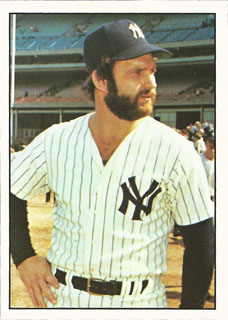
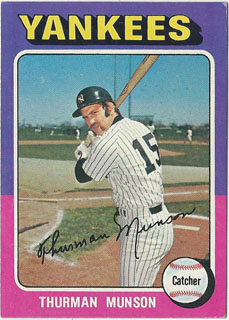
Strike a Pose.
Porter migrated to handle bars and Thurman migrated to a beard.
I haven’t seen a pose like this one on a card, so until I know different, this is a unique one of a kind.


Nickname appropriate.
Catfish Hunter’s SSPC card pictures him in a pose that matches his nickname.
If you bought a Topps card in 1975, his card showed him as an Athletic but he was really a Yankee by then. If you own the SSPC card, that covers both teams he played on (though technically he started as a Kansas City Athletic).
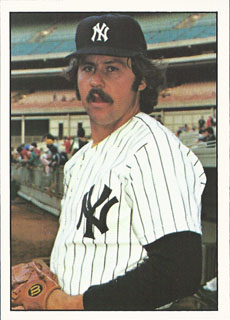
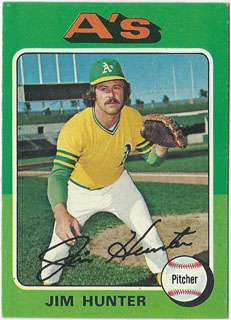
Bake McBride is another player with an SSPC card that’s more nickname appropriate.
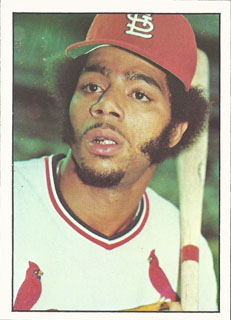
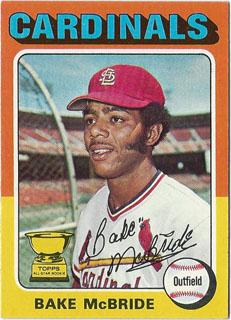
Perspectives.
Some of the photographs in the 1975 Topps and the 1976 SSPC sets are so different it’s hard to tell it’s the same person. And others, like this one of Rudy May are more subtle.
I was used to the sullen Topps Rudy May that I’ve grown accustomed to for decades. When I picked up the SSPC recently, there’s familiar Rudy with the same glasses (a little crooked), a Yankees cap (not airbrushed), and sort of a grin. Plus he’s got a gold chain.
And there’s more. More of his Yankees uniform. More of the background with a stadium full of fans.
That’s what I like about this SSPC set. It’s a different perspective on familiar faces from the Topps set. And that’s pretty cool.
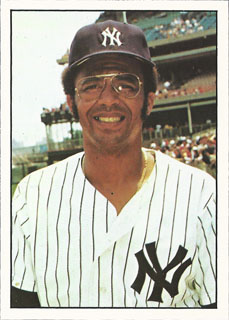
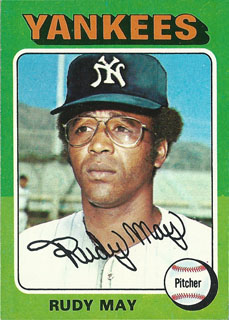
Mesmerizing.
This might be one of Nolan’s weirdest cards. It’s like he’s practicing pitching. I like the focus and intensity it captures. I also like the stadium and fans in the background.
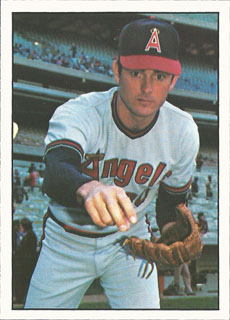

Built-in Traded Set.
This is the last card of Oscar Gamble in an Indians uniform. The back of the card highlights his trade to the New York Yankees in exchange for Pat Dobson. In his career, Gamble switched teams eight times (including two repeats: the Yankees and White Sox).
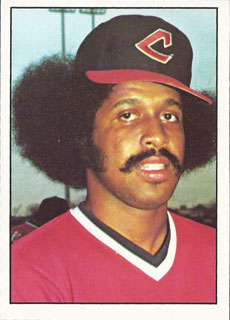
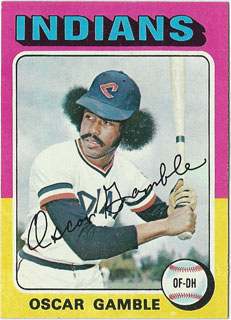
SSPC took full advantage of the timing of their release to include the trades after the 75 season. So the SSPC set is a base and traded set all in one. And that’s why this Oscar Gamble “Traded” card is among my 1976 SSPC favorites: to commemorate the coolness of that idea.
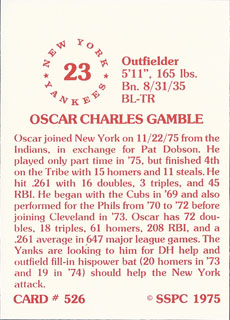
The 1976 SSPC set is one of my favorites: 630 photos that are candid and sometimes funny. It’s a great complement to my absolute favorite set (1975 Topps). This month, I’m starting a countdown of my favorite SSPC cards presented as 25 themes.
There’s occasional confusion about the true year of the 1976 SSPC set. It’s copyrighted 1975, but was released in 1976. A letter from SSPC calls it the 1976 SSPC set, and that makes it so.
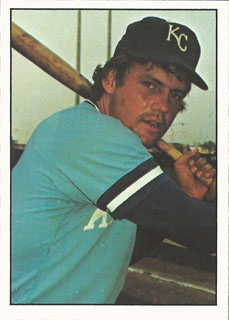
You may also see this set called the SSPC Pure Card set (named because of its clean design based on Bowman’s 1953 cards). I like the design, really like the photographs, and the cards are (mostly) ordered by team, which is a bonus.
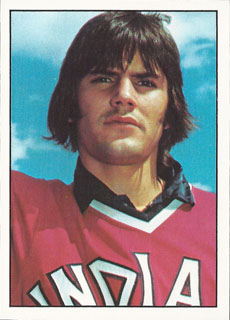
This set also has an interesting backstory:
TCMA produced oddballs from 1972 to 1987. TCMA stood for Tom Collier and Mike Aronstein (the co-founders). But shortly after starting the company, they started calling it The Card Memorabilia Associates.
Sports Stars Publishing Co. (SSPC) was a TCMA offshoot that published a magazine called Collectors Quarterly (edited by the Keith Olbermann we all know from TV).
Olbermann writes about his experience in this blog post: “I had written the backs for the first [1976 SSPC] set, and another fellow had taken most of the photos for them, only it turned out he didn’t really have any ballpark credentials and was only on the field because he’d been a batboy and knew all of the cops at Shea Stadium and they just let him sneak in.”
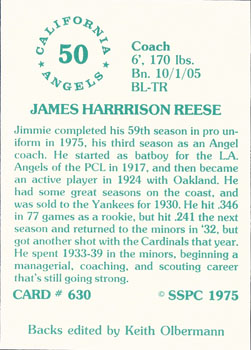
Keith Olbermann’s contribution (writing the text on the back of every single card) is documented on the final card back.
The Winter 1975 Collector’s Quarterly had a two-page insert of 18 cards that are a precursor to this set.
It got interesting when Topps sued and blocked further production. After negotiations, SSPC was allowed to sell their existing inventory as long as they didn’t produce any more. According to Internet posts, the initial print run was 10,000 sets.
A second set was made from the negatives without permission and it’s unknown how many were printed (it contains a Nolan Ryan error card – with his name listed as Noland). So it’s unclear how many total sets made it to the public.
I’ve seen cards from both sets and it’s hard to tell which is which. And I don’t care enough to discover which one I have. And it doesn’t seem like anyone else cares because cards sold online don’t differentiate. At this point I think the inventories have mixed into the general population.
I mentioned a letter – it’s said to have been included with sets sold directly by SSPC, and it reads like this:
SSPC letterhead from 100 Ringgold St., Peekskill NY 10566
Dear Baseball Fan:
We are very happy to report that the lawsuit has been resolved. Enclosed you will find your set of 1976 SSPC cards that you have waited so long to get. These cards are being shipped to you by Renata Galasso Inc. This company is doing the sorting and mailing of the cards for us. If you wish to purchase any additional sets you may do so by consulting the enclosed flyer and ordering directly from Renata Galasso Inc. Thank you for all your support during the time it took to end the lawsuit.
Sincerely,
Michael P. Aronstein
President
I haven’t seen it personally, and I’d really like to get ahold of an original or a copy. So if you have one let me know.
The last cards I bought fresh out of a pack are considered vintage today. Back then, parallels meant 1975 minis.
We didn’t have serial numbered cards. Rainbows were in the sky not a parallel card set. It was a simpler time.
I miss it, but I also can’t help myself when it comes to 1975-look-alikes. So when I saw the 2015 Mini set was about to go on sale with a 1975 throwback style subset, that sucked me in.
The concept isn’t new. Topps put current and former players on a 1975 design before (one of the better renditions was 2011 Lineage):
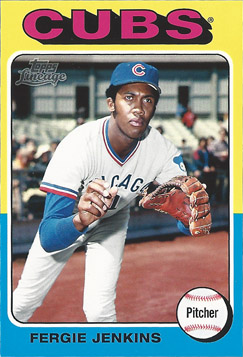
This 2015 subset would be just as good if it had some vintage ’75 players. It was only available through Topps (it’s now sold out). This is what they look like:
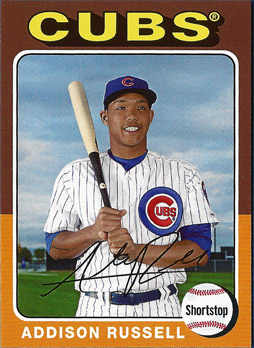
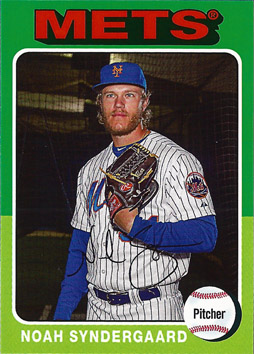
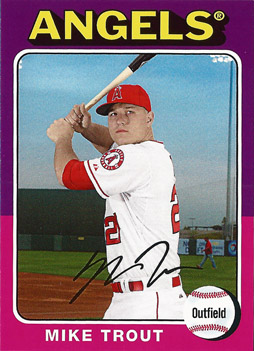
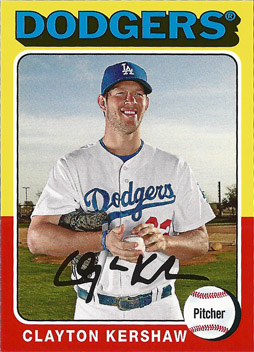
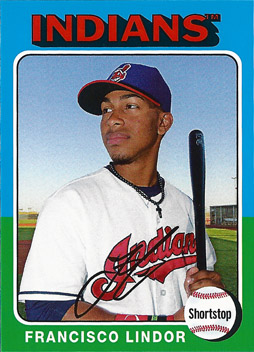

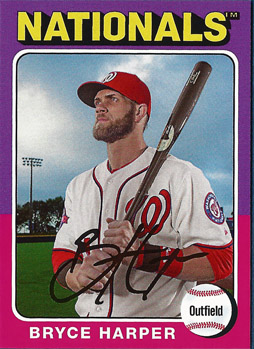
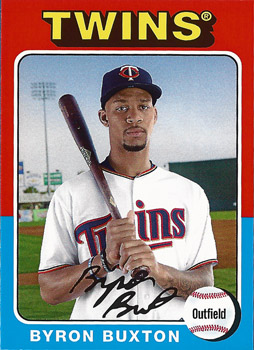
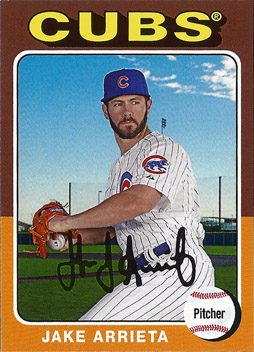
This 2015 rendition has posed shots, but they’re solid photographs. The backs limit the overall appeal: every card has the same text and cartoon (lifted off Sal Bando’s 1975 Topps #380 card). Even with boring backs, they’re still nice cards and you get a rookie Kris Bryant variation.
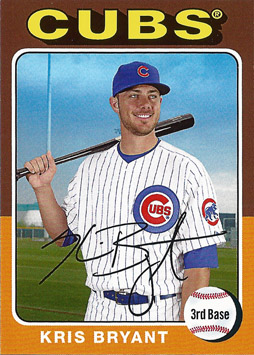
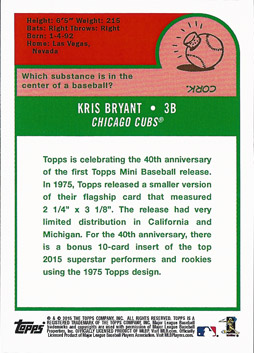
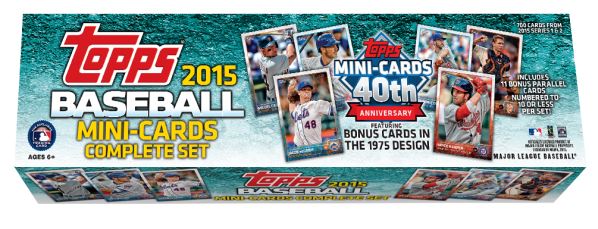
I’ve been wondering how Topps was going to celebrate the 40th anniversary of the 1975 mini release. This past week we got the answer: a complete mini set of the 2015 Series 1 & 2 cards. But the icing on the cake is 11 parallels and 10 cards with a 1975 design.
I’m a 1975 collector. I’ll get into modern cards if they have players from the 1975 set on a 1975 style card. But the anniversary of the minis and my getting back into collecting this last year means this set’s my Christmas gift.
I don’t know how the parallel split will work out. Based on the description, Topps will put a total of 700 gold, 3500 red, and 7000 black parallels in the packs (11,200 cards). There are “Less than 1,000 boxes available” so I don’t know if there are really 700 boxes and everyone gets a gold or if there’s a random split where one person gets all reds and another gets multiple golds. I’d rather get a guaranteed gold, but I guess that’s part of the gamble.
This is one of Topps’ online exclusives at $100 for the box. At first I thought they might sell out quickly, but noticed that the Topps Legacy parallel (also $100) was still around so figured it could take a while. And almost a week later this mini set is still available today.
I got curious about the dynamics of how these sets show up on the resale market because I thought about selling the base cards as team sets (though I’m still undecided). I’m most interested in the 1975 cards and didn’t want to get into bidding wars or pay a lot for 10 cards. Plus I’ve never opened a pack with parallels, so that’s a bonus experience and they may be interesting to keep.
But a truth I’ve discovered with card collecting is that if you have an idea, it’s almost certain a bunch of other people do too. The box breakers are already out in full force.
The angles to reselling these are: full base set without the subset or parallels, team sets, individual inserts, and select base rookies. No surprisingly, there’s a lot more eBay resale action with the minis than Legacy, which doesn’t have the parallels or subset. So maybe the minis will sell out faster on the Topps site.
I’m not one of those people obsessed about card values. And that’ll make it interesting to see the process of the cards finding their value without having any angst about it. I haven’t paid attention to this before.
On that note, what do the eBay tea leaves tell us today?
I can’t wait to see what parallels I get…
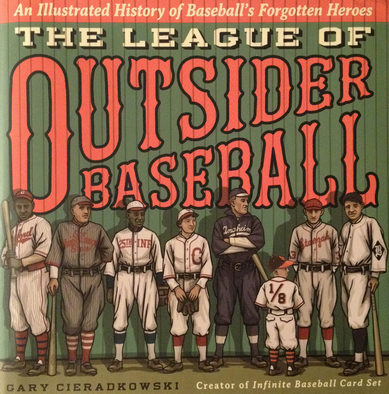
While searching for new blogs to read, I stumbled on a special book by Gary Cieradkowski: The League of Outsider Baseball.
While in art school, Gary traded baseball player trivia with his dad at least three or four times a week – the more oddball and obscure the player, the better. Then in 2009 his father unexpectedly passed away.
One day Gary had an inspiration to draw tobacco-sized baseball cards like ones he shared with his dad. He posted them on the Infinite Card Set and discovered it was a way to reconnect with the exchanges he had with his dad.
His work stands out because of his artistic skills and a knack at digging into baseball’s historic archives. It’s easy to see he’s got a passion and talent for this (see his process here and here)
There’s more to Gary’s stories than past history – they impact people today. After a blog post, he got separate e-mails from a couple of a player’s descendants. The relatives didn’t even know of one another, but Gary was able to connect them.
This book flows so smoothly, I found myself quickly immersed in baseball history. It’s a fun read and it may impact your life in unexpected ways.
I think his father would be very proud of Gary’s book.
Overview
My first impression is that The League of Outsider Baseball feels more significant than what you see online. It’s thick, glossy, and colorful and feels plush. If you end up buying it, do yourself a favor and get the physical book instead of a digital version.
The short story format lets you decide if you’ve read enough about a player or if you want to dig in and learn more on your own.
Take Walter Johnson, the Nolan Ryan or Bob Gibson of his day and even today. I hadn’t heard of him so I checked Wikipedia and found that 88 years after his final MLB appearance, he’s still the all-time career shutout leader. More importantly, he’s still thought of as a highlight of good sportsmanship and friendly competition.
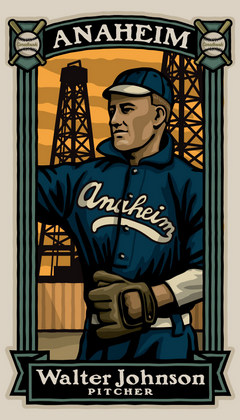
I like reading about inspirational role models like Johnson
The book’s portioned into seven chapters. Bush Leaguers is full of familiar names: Jackie Robinson, Roberto Clemente, Babe Ruth.
It shifts to lesser known players – the Could’ve Beens like Steve Dalkowski, who finally made it to the majors after years of trials. He even had a rookie card produced (Topps 1963 #496), but injured his shoulder during his first game, which ended his career in the majors. Those are the kind of stories that get me started on the hunt for new cards to collect. It’s also a good reminder of how amazing it is for anyone to get to play in MLB.
Bad Guys is about what you’d expect. People’s Game digs into baseball as a common theme among people who are known for things other than baseball (like George Bush, Fidel Castro, and Frank Sinatra).
Baseball isn’t limited to America (or Canada’s remaining MLB team). So International Game shares stories from other countries like Japan, Mexico, Russia and beyond.
Chinese- and African-Americans, as well as other races are covered in Race Game. It includes Gary’s brush with greatness with Leon Day, a pitcher in the Negro Leagues. During Gary’s senior year in art school, he worked on the Camden Yards graphics including the Oriole Park logo. He met Day through a mutual connection from that project. They became friends but Day was pretty humble. It wasn’t until Gary researched Day that he understood why Day was eventually inducted into the Hall of Fame.
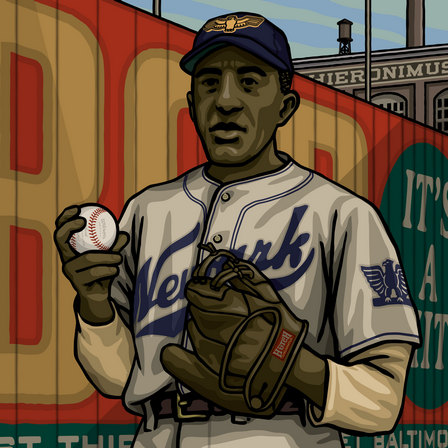
The larger illustrations that capture the time period are my favorite
The final chapter wraps it up with Odd Balls – those players outside the norm, like the only female to have played in an MLB game.
Gary told me, “I chose players thinking I would have fun talking to my dad about them or they’d be someone he would have told me about. That’s still my criteria: would my dad be interested or would we have a phone conversation. If my dad’s interested chances are other people would too.”
The formula works and the result is a book that lets us experience a bit of the discovery and magic that Gary and his dad shared.
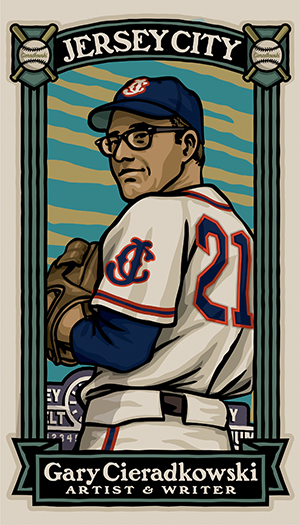
Questions and Answers with Gary Cieradkowski
Q: Amazon Reviews has a comment from Paul Gillespie’s daughter (July 28, 2015). Have you heard from other relatives or players you’ve written about (beyond George Bush)?
A: Yes I get many letters from relatives. That’s one of the great side-effects of the website and book, the interaction with the families of the players. Kenso Nushida’s family have been very nice to me and I’ve met quite a few of them and corresponded with many others. They even sent me a photograph of his sister posing with my portrait of him. That was a very nice gesture and it meant an awful lot to me. One of my early stories on my blog was about a little-known guy named Overton Tremper. He played very briefly with Brooklyn in the early 1920’s and then played semi-pro baseball around NYC up until the late ’30’s. As soon as I posted it I received 3 emails from his descendants, none of whom knew of the others existence and lived in 3 different parts of the country. Now the 3 groups of relatives are reunited, all because of a story of an obscure ballplayer from the 1920’s. Kitty Burke’s family was very helpful and with their assistance I was able to write the most comprehensive story on her life out there. She is no longer a 2-line footnote in baseball history – I’m very proud of that.
Q: Some people think your card and book art is based on the Works Progress Administration style. How would you describe the art style?
A: I think people say WPA style because of the bold colors. Personally I am more inspired by turn-of-the-century poster artists Edward Penfield, Will Bradley and Henri de Toulouse-Lautrec. If you look at their work you can see where my dark line style with bold color comes from. Some people have likened the style to the Japanese menko cards of the 1950’s-60’s. Those are more cartoon-y than my work but the line and solid color is there. So if I had to describe it I’d say it was cross between the turn-of-the-century poster art with some 1950’s Japanese menko baseball card style sprinkled in. [See this link for some examples of posters Gary’s: posters]
Q: What was your criteria for choosing the players in the book?
A: When I originally turned in the manuscript it was 100 pages OVER the 240 pages it was supposed to be. I began editing players out, first keeping the most popular players because they would be familiar to most people. But I was very unhappy with it because it cut out the players I personally liked: the unknowns whose stories are rarely told. My wife had the greatest piece of advice I received while writing the book – she said “Don’t worry about what you think people want – make the book YOU always wanted to find on a bookshelf”. And that’s how I settled on the players in the book. I think it is a nice mix of well-known and un-known. When I finally received the printed book I read it cover to cover and said to my wife “This IS the book I always wanted to find on a bookshelf”.
Q: What year did you start writing the book?
A: I started May 2014 and submitted the final manuscript beginning of August 2014.
Q: I’ve read you’ve received many awards. Which are some that you’re proudest of?
A: This year The Baseball Reliquary awarded me the 2015 Tony Salin Memorial Award for commitment to the preservation of baseball history. I am particularly proud of this because of three reasons: 1) I had no clue I was even nominated 2) I was awarded it BEFORE my book was out so it was for my previous work, not just because I had a book on the shelves and 3) There is no more prestigious award a baseball researcher/writer/artist can receive. The Salin is not political, or given out to popular celebrities to make headlines. It is awarded purely on merit and accomplishments. I am proudest of this award. As an artist/designer I’m supposed to win awards because I am good at what I do. It’s expected. But to win the Salin, which is awarded for writing and research, that’s something else entirely. Many of my favorite writers/researchers are past recipients of this award and man, that’s a great feeling!
I’ve received many other awards for my design work, the most important to me are the “Best Sign Design 1992” which was for the Clock at Camden Yards and was my first award. I am most known for my posters and my work won Gold medals from Graphis, the most prestigious of annual poster competitions, in 2007 and 2010.
Q: You have your own design company – how did you start that?
A: I went out on my own in 2009. Mostly because I like to do a variety of different types of work: posters, print, branding, illustration, props for movies and TV, package design, environmental graphics – and no place I worked at let me exercise my design skills in such a diverse range of projects. Tough part is that I am not a relentless salesman, I find it very hard to sell myself because I tend to be modest and don’t like pushing my work on people. I really need an agent but so far have not met anyone that was compatible. It’s been a challenge, but very, very rewarding.
What’s next for Gary? He’s planning to continue the blog. And he’s thinking of a volume two focused on the same era: pre-1955. “I stop in the 50’s. After that there’s newspapers, TV, and radio that take the mystery out of it for me. When you research in the 1930s, it’s funner there’s some imagination left in it and it seems more interesting.”
He’s also considering writing a children’s version of the book for young adults (10 or 11 to high school). “No brothel stories or suicides,” Gary said. “I’ve been getting letters from fathers and moms wanting to get their kids interested in baseball. I found parents like the book. With kids into video games, they try to get them into sports. And the history of baseball is interesting. Once kids catch an interest there are a few characters they gravitate towards.”
Thank you Gary for the book and for sharing more about yourself.
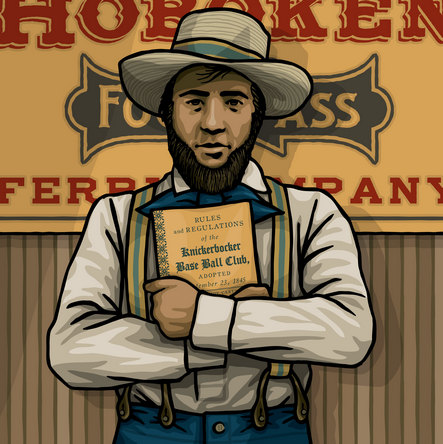
I’m always looking for cards that commemorate 1975. So when I saw a card from this year’s Topps Highlight of the Year subset, I immediately checked and found a 1975 highlight on COMC.
There are 30 cards in the subset. The odds are 1:4 packs, so they’re not rare, which is fine since it translates into a card that’s less than a buck.
The 1975 card celebrates Willie McCovey’s third Career Pinch Grand Slam. McCovey is still tied for that record with four other players (two in each league). Plus he’s still the National League Grand Slam holder (and tied for 5 overall).
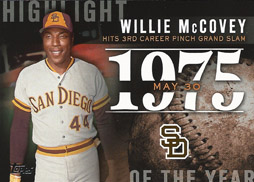
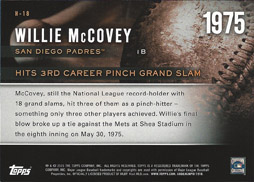
I like the card. It’s got a gritty feel to it. And does the photo look familiar? Topps lifted it from the 1975 Topps Set. I like the tribute and tie-in to my favorite set:
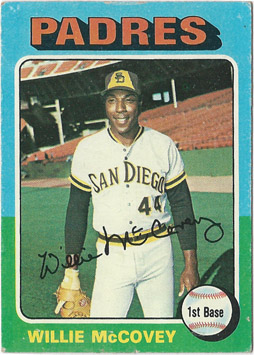
By the way, COMC is the best source I’ve found for modern cards because you’ll usually find the best prices and you can combine shipping from many sellers. And equally important is the fantastic support they provide. With eBay sellers, I’ve had mostly positive experiences, but some were lemons. But with COMC, every person has been friendly and every order has been great.
Currently their standard shipments include the scratch-off card below (until they run out). So if you’re about to have cards shipped to you, this is what you’ll get:
